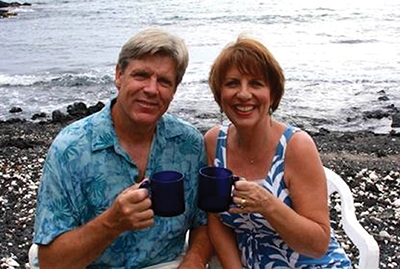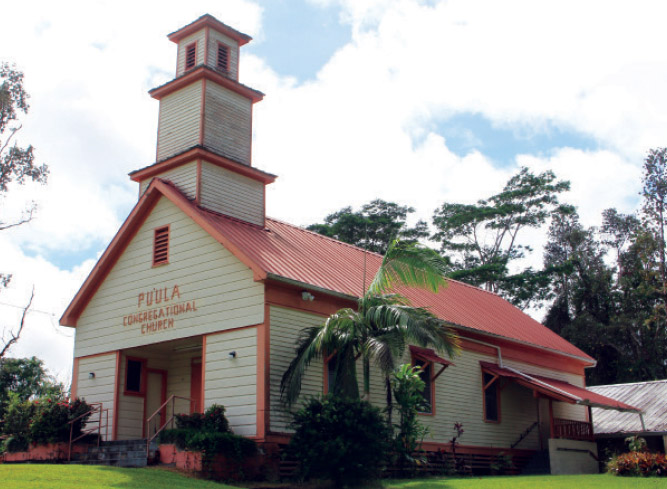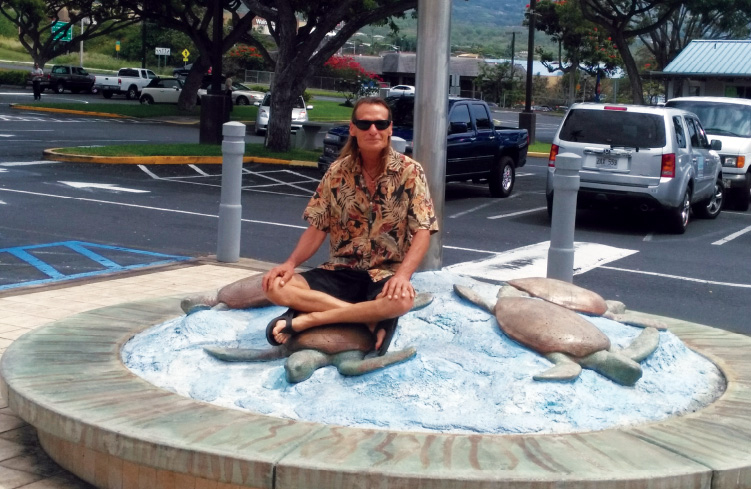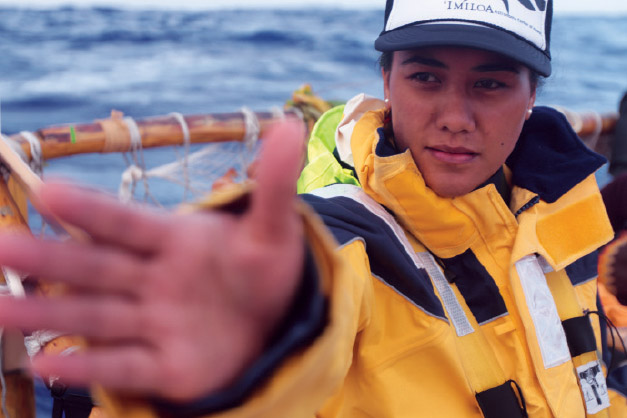
Navigating From the Na‘au: Worldwide Voyage Update with Celeste Ha‘o

Navigating From the Na‘au
By Le‘a Gleason
In the car on the way to meet Celeste Ha‘o, navigator of the Hōkūle‘a, I wonder if I might cry during our interview. Some people just wear certain integrity on the outside, and I’m told Celeste is one of those people.
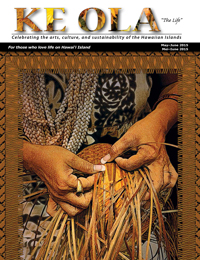
After a quick greeting at the desk of ‘Imiloa Astronomy Center, out walks a beaming young pregnant woman in a floral mu‘umu‘u, and I can already tell.
There’s always that moment in meeting a new friend—eyes meet, words exchange, and then, all of a sudden, a moment of truth so clear and precise it’s like holding a magnifying glass straight up to the heavens. In that moment of connection, emotion overwhelms.
Celeste is one of those people who seem to speak truth like that all the time, and hers is a story of connection to something much bigger than all of us.
She was born and raised in Keaukaha, a surfer who knew the water well, but never thought she’d one day sail on it. At 17, she went with her parents to ‘Upolu, Samoa, to visit her grandfather, Tialavea Morris, the Ali‘i and High Chief of Faleapuna.
Grandpa had called them there for a special reason: Celeste was to become a Taupou (female leader) of the village, a right that could only be bestowed by a male elder on his daughter or granddaughter. Instead of asking her to stay and lead her people, the Chief instead directed her to return home and focus on her studies.
Celeste ended up at the University of Hawai‘i at Hilo with an internship as a planetarium operator at ‘Imiloa Astronomy Center; she’d wanted to be an astronomer since the fifth grade.
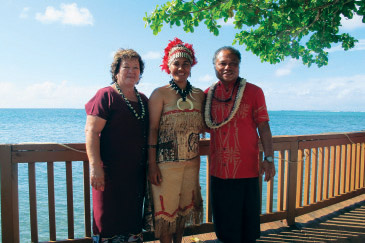
There, she met Master Navigator Kālepa Baybayan, who has sailed on Hōkūle‘a since 1975. Kālepa took Celeste into the planetarium and showed her what he saw in the night sky as a navigator.
“Right there in that instant I saw everything: astronomy, math, art, science, culture, stories; everything was captured within his mind as a navigator and I was like, ‘I want in on that,’ ” Celeste remembers.
She was given two months to accomplish the task of entering Hawaiian cultural content and stars into the planetarium system so that it could be used for crew training for navigating voyages. During this time, Kālepa saw her dedication and became her mentor.
For the last eight years, the two have trained together.
Four years ago, Celeste mapped the sail plan for the ‘Te Mana O Te Moana’ maiden voyage of seven canoes, or “Vaka Moana” from Aotearoa (New Zealand) to Hawai‘i.
“My portion is with celestial movements. We can go back or forwards to any time, date, hour, second… my job was to go in and watch all the stars that would rise and set during that time frame, put the sail booklet together, and send it over to them,” Celeste says.
Other times, she worked in the planetarium dome helping wa‘a (canoe) crew study the stars.
Then, in 2013, her grandpa called and told Celeste she would come home and educate the people of her village, and that her homecoming would be by way of sea and stars, just as her ancestors had done, and that she must bring her navigational master.
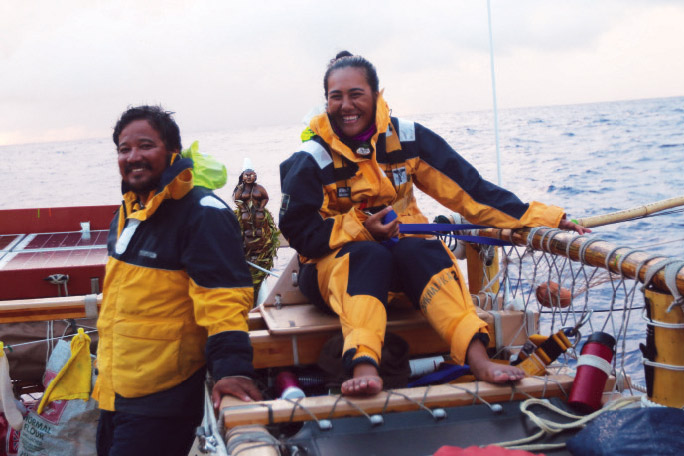
Try as she might, Celeste could find no way to sail to Samoa. She and Kālepa tried for two years, but there wasn’t a crew, or there weren’t canoes, and everybody was going to be leaving soon on the Hōkūle‘a and Hikianalia’s World Wide Voyage.
In 2014, Nainoa Thompson and the Hōkūle‘a crew came to study stars at ‘Imiloa. It was May 28—Celeste’s birthday.
“I told my husband if there was anything I wanted for my birthday, it was just to let me get my voyaging fix…to stay inside the planetarium with the crew [that night]. For the past four years I’d been pregnant, so I’d been landlocked. I had just given birth six weeks prior to that night,” Celeste says.
Before the crew came in, Uncle Nainoa came in to go over some stars. On their way out, he told Celeste, “I really think you should come…I don’t know what it is, but I just feel like you have to come. Consider a short stint that goes from…I don’t know if you’re familiar with Samoa.”
After committing to the one-week leg of the voyage that would sail between American and Western Samoa, Celeste realized the sail plan made it so that one could easily see the glow from Western Samoa, so true navigation wouldn’t be needed.
She talked it over with her husband, and realized that to make it an honest voyage, she’d have to sail from the previous destination, Aitutaki, Cook Islands, and into Samoan Waters. That leg, however, would take over a month. With three weeks left to decide, her amazingly supportive husband agreed to watch their three kids (including a three-month-old) so Celeste could fulfill the voyage of a lifetime.

Celeste is smiling now, remembering the excitement of that moment. I tell her I know nothing about navigation, and that many of our readers likely do not either. I apologize for asking questions a novice might, and she just smiles warmly.
She holds out her hand in a fist, with thumb and pointer finger extended. Each navigator must calibrate their hand, and for her, it’s 15 degrees to the tip of her finger.
Navigators look for the sun, the moon, stars (Hōkūle‘a, or the north star, is an important one), and patterns in the night sky. Once they’ve located these things, they can use their hand as a compass and complete a mental map around the horizon.
On the water, the wind and the waves become key factors in ways Celeste says she never realized beforehand. When she got to Aitutaki, she had to choose whether to stay on Hikianalia with Kālepa, or to undertake the task of head navigator of Hōkūle‘a. She chose Hōkūle‘a.
“The stars are my bread and butter. Because I hadn’t had a lot of time on the water, I didn’t understand the waves and the wind. But there are [also] times when you have none of those,” she says.
It was the final eight hours of the journey that would test her navigation skills to the core.
“We had a lot of bad weather and adverse winds over nine days, [and] we had three nights where for a couple of hours it was just gorgeous. I’ve never seen that many stars in the sky—so bright, that you could see the reflection of the Milky Way off the water,” she says.
When Ta‘ū, the easternmost island of American Samoa was close, she asked Tua Pittman, Pwo Master Navigator from the Cook Islands, what to look for. Tasked with looking for “strange clouds,” she spotted what looked like a cliff in the distance and thought, ‘that’s my island.’
Up ahead though, a big squall loomed and was fast approaching.

“All of a sudden, it was right on top of us, and as soon as it hit, it clocked us around and shot us away from Hikianalia within two minutes. You talk about lost, scared, disappointed in yourself, pretty angry…I looked at my master with tears in my eyes and said, ‘Uncle, I am lost. I have no idea,’ ” she says.
Tua told her, “This is a point where you take everything you’ve learned, every book you’ve read, and you throw it off the canoe. This is a time where you feel your way home.”
At this point, I’m sitting on a bench with Celeste in a sunny garden outside ‘Imiloa and we’re both crying. Any other person, telling a story in which they admit defeat, might be overcome with shame. Not Celeste—she’s smiling through her tears, like all this is just another important lesson.
Eventually Celeste would move to the front of the boat to pray to ask Ke Akua and her ancestors for help. They’d cleared the first squall, and everything inside her told her to instruct the captain to continue forward into a squall ahead of them, despite her rational brain telling her they should turn around.
After two cold, rainy hours, they spotted Hikianalia in the squall, and together the two vessels broke through the clouds to a stunning view: a lush green island, with birds flying overhead. Looking back, that’s when Celeste says she started to cry.

“To come through all of that, not have a clue, and just trust, and to see it come through in the end, that is navigating my na‘au (instinct). I was blessed to be able to learn a very valuable lesson. Our ancestors understood learning in a very different way than we’re accustomed to. It’s holistic—the mental, physical, and spiritual are important,” she says.
Celeste was able to do another thing: bring the hope of voyaging back to the land where it was born.
“My grandfather said, ‘My hope and my prayer is that when your people see you come home this way they will be inspired to leave our shores’…it wasn’t until I got home to my village that I realized when you bring back the canoe, you revitalize the va‘a. You bring back all the values that come with it: what it’s like to live together as one, to work together, to have to rely on the next person, to know how to conduct yourself, be compassionate, committed, and dedicated to an end goal.”
For the past two years, Celeste’s work at ‘Imiloa had been to create voyaging curriculum for grade-school children and help them build “connection to place.” Now, this will become a template she can take back home to Samoa, as she was tasked with creating a school of navigation there.
“I thought taking this voyage would be like a ‘check, and we’re done.’ That wasn’t the case. When you learn something new, and rise up to the challenge, you get more kuleana (responsibility) after, but it’s all the stuff I love anyway, so I consider myself really blessed,” she says.
Celeste smiles and dries her tears, a soon-to-be mother of her fourth child, who won’t be going anywhere soon. When she says what comes next, it isn’t just something she comes up with, it’s one of those celestial truth moments.
“The beautiful thing about voyaging is it doesn’t matter if you’re a navigator and you’re going on the canoe. Voyaging is just a metaphor for life. Everybody is a navigator. Everyone will have to look at the people and the things around them, and decide who it is that guides you. And once you set up those things, and you understand exactly where you want to go, then it’s easy to trust,” says Celeste Ha‘o.
Contact Celeste Ha‘o: chao@imiloahawaii.org, 808.969.9700
Contact writer Le‘a Gleason.
